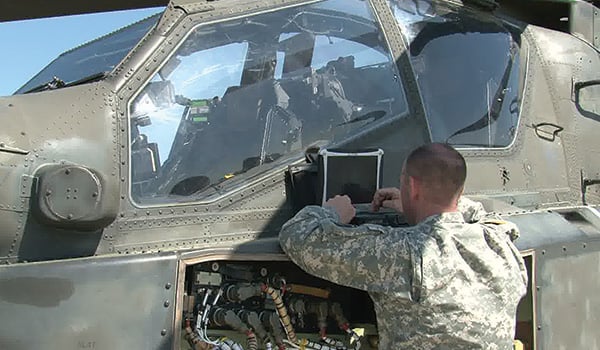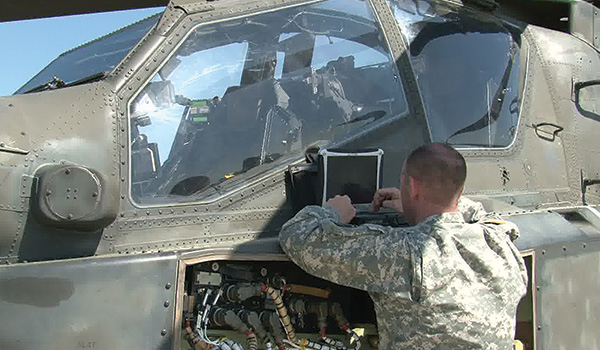
Branch Command Sergeant Major / By CSM Glen Vela: Army Aviation’s Condition Based Maintenance Plus (CBM+) initiative, launched over a decade ago, has four objectives: reduce soldier maintenance burden, increase platform availability and readiness, reduce operations and support costs, and enhance safety. These objectives are still relevant today, perhaps more now than before.

Working Condition Based Maintenance Plus (CBM+P) on the flight line./ U.S. ARMY PHOTO
Generating combat power, whenever and wherever needed, for as long as needed, without compromising safety, and at a cost affordable to the Nation – that’s why we need CBM+.
Historically, commanders require more combat power, more training flights, and increased readiness. This translates into a requirement for improved maintainability within our Aviation fleet. The maintenance community continually answers that call, coordinating and pushing to get the next aircraft Fully Mission Capable, learning lessons, improving techniques and procedures, sharing those best practices with the school house and AMCOM logistics assistance representatives (LARs), and communicating their needs to project managers (PMs). Army Aviation, even in the most challenging environments, rose to the challenge. Collectively, we can make Aviation maintenance better.
In reality, we have been doing CBM+ for years; we called it maintenance. Everyone has completed maintenance based on evidence of need, typically unscheduled maintenance. Unscheduled maintenance is hard to manage: happening when maintainer availability is low, funding is restricted, parts are not in stock, and you’re limited on diagnostic capability. Worse, it happens when the aircraft is demanded most, when Soldiers on the ground need Army Aviation.
CBM+ is a component of Aviation’s overall maintenance strategy, running parallel with, and providing support to, other programs like the Army Oil Analysis Program (AOAP), Corrosion Control and Prevention (CCP), and Non-Destructive Testing and Inspection (NDTI). Digital Source Collectors (DSC) are installed across the operational fleet. When properly employed by maintenance personnel, the science and art of vibration management reduces Solder maintenance burden, improves component reliability, reduces the cost of components, and improves safety. Yet, if you ask a Soldier how much time the DSC has saved, they probably wouldn’t be able to say. Most of the aircraft were modified before they entered the Army. These systems are doing so much, and capable of much more. All data sent to Redstone, from every aircraft and flight, improves diagnostic thresholds, and enables the development of more.
What if a fault could be identified before it’s a fault, an accident prevented before it’s an accident? What if you could reduce the amount of time required to maintain an aircraft by planning and packaging maintenance based on a forecasted need? Result: reduced maintenance man hours and lower parts cost because you know precisely what is failing, therefore what to repair or replace.
Readiness, maintenance, and cost are all important, but moreover, CBM+ enables safer operations. You can’t put a cost to accidents that didn’t happen, not knowing the extent of damage that didn’t occur or lives not lost, or the guard force and recovery team not deployed to the site. The reality, faults found prior to being a catastrophic event is a win – even if you can’t show cost avoidance based on speculation.
As the Army cuts strength and funding, Soldier maintainers carry the bulk of the maintenance burden going forward, requiring adherence to exacting standards in training and maintenance. Because of our nature to exceed the standard, I am confident Army Aviation will perform, as always “Above the Best.” To generate the required combat power, maintain the largest margin of safety, and control costs we must exploit all available advantages. Maximize employment, optimize capabilities, and train DSCs in our schools and on the flight line.
We have to synchronize maintenance efforts to meet mission, exceed training and readiness standards, providing a safer operational environment, at a cost the Army and the Nation can accept. Employing CBM+ today, developing new maintenance tactics, techniques, and procedures, and working diligently as a community of excellence will improve our fighting position for generations to come.
That’s the pitch; so now it’s your turn to help the Enterprise. After you have shared this article with other maintainers and talked the pros and cons, provide me your feedback on CBM+ in the institutional domain. It’s not every day you get direct input into the decision making of our Branch so think it over and hit me up with your thoughts.
As always it is an honor to serve as your Branch Command Sergeant Major. Above the Best!
CSM Thom
This email address is being protected from spambots. You need JavaScript enabled to view it.
CSM Glen Vela is the command sergeant major of the U.S. Army Aviation and Missile Life Cycle Management Command (AMCOM).
CSM Eric C. Thom is the command sergeant major of the Aviation Branch and the U.S. Army Aviation Center of Excellence, Fort Rucker, AL.










